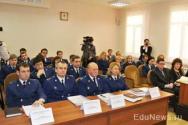Summary of a lesson on reading fiction in the senior group “Reading V. Kataev’s fairy tale “The Seven-Flower Flower”
Sections: Working with preschoolers
Senior group
Subject:
“Visiting the writer S. Ya. Marshak.”
Goals and objectives: To summarize children’s knowledge about the writer and his works. Continue to teach children to memorize poems. To develop intonation expressiveness of speech and artistic abilities of preschoolers.
Cultivate an interest in literature, a desire to get acquainted with the work of Marshak.
Equipment: books by S. Ya. Marshak, illustrations for his works, a portrait of the writer, costume attributes for reading and dramatizing poetry, schematic drawings for memorizing, origami crafts, colored pencils.
Preliminary work:
Reading to children and listening to audio recordings of works by S.Ya. Marshak. Word games and exercises to develop tempo, timbre, melody of speech and logical stress. Learning by heart excerpts from the poems “Mustache - Striped”, “He’s so absent-minded”, “Luggage”, “A Lesson of Politeness” and dramatizing them. Making origami “cat” crafts with children
Progress of the lesson
Today we will go to visit the writer and poet S. Ya. Marshak. Take a look at his portrait. He lived a long life - 77 years. You, your mothers, fathers and even grandparents know his books.
Now the children of our group will perform in front of you. And you look, listen and remember the names of these works.
1) The girl began to teach the kitten to say:
- Kitty, say: ball.
And he says: meow!
- Say: horse.
And he says: meow!
- Say e-lecture-three-thing.
And he says: meow-meow!
All “meow” and “meow”!
What a stupid kitten!2) He sat down on the bed in the morning,
He began to put on his shirt.
He put his hands into the sleeves -
It turned out that these were trousers.
He went to the buffet
Buy yourself a ticket.
And then I rushed to the cashier
Buy a bottle of kvass.3) Gave it to the lady at the station
Four green receipts
About baggage received:
Sofa, suitcase, travel bag,
Picture, basket, cardboard
And a little dog.4) A bear about five or six years old
Taught how to behave:
- Away, bear
You can't cry
You can't be rude or arrogant.
We must bow to our acquaintances,
Hats off to them
Don't step on paws.
Now look at these illustrations. Do you recognize what fairy tales or poems they are drawn from?
Guys, you know, it turns out that Marshak studied in England at the University of London and traveled around the country a lot. During these trips, he learned various English poems and nursery rhymes and translated them into Russian for us.
Today we will learn by heart a short poem called “Conversation”
Aunt Trot and the cat
Sat by the window
Sat next to each other in the evening
Chat a little.
Trot asked: Kiss-kiss-kiss,
Can you catch rats?
“Purr,” said the cat,
After being silent for a while.
Parsing the text. Sample questions for children.
1) Name the main characters of the poem.
2) What kind of owner do you think Aunt Trot is for her cat? Describe her character.
3) How does Aunt Trot talk to the cat?
4) What intonation is heard in her voice?
5) What kind of cat do you think it is? Tell us about her.
6) What do you think the cat wanted to say with its “murr”?
Let's look at schematic drawings that will help you learn this poem.
Children recite a poem according to a scheme with the help of a teacher, and then independently.
At the end of our lesson, I propose to paint the origami “cats” that we made with you in advance. Let your cat have its own special coloring and character.
Subject:
“In a fairytale yard.”Goals and objectives: Recall with children the meaning of the word “fairy tale”. Summarize children's knowledge about familiar fairy tales. Teach children creative storytelling; connect selected objects into a single storyline, develop the ability to compose a fairy tale text. Teach children, based on a familiar fairy tale plot, to invent a new fairy tale, tell it meaningfully and emotionally, using expressive means, traditions of the beginning and end of the fairy tale. Develop speech creativity of preschoolers. Cultivate interest in literature, love of books, friendly and correct attitude towards each other.
Equipment: set of flat figures fairy-tale heroes, multimedia equipment (projector, screen).
Progress of the lesson
- Guys, today we will talk about fairy tales. What is a fairy tale? How do you think?
(Children's answers)
Who comes up with fairy tales?
If a fairy tale knocks on the door,
Hurry up and let her in
Because a fairy tale is a bird,
If you scare me a little, you won’t be able to find it.
I suggest you play with fairy tales.
Let's collect a bouquet of fairy tales you know and love. Name the fairy tales and look carefully at the screen.
Interactive game “Bouquet of Fairy Tales”
- Now I’ll check how well you know fairy tales.
Listen carefully and guess what kind of fairy tale it is:
Interactive game “Guess the Fairy Tale”
He left his grandfather
He left his grandmother.
Round self, ruddy side,
And it’s called... ( Kolobok)Only the door closed behind the goat,
It’s like there’s already a hungry beast...
Each of the children knows the fairy tale:
This … ( Seven kids)Emelya was lying on the stove,
I suffered from idleness for a long time.
And then luck started
All … ( By pike command )He is not low, not high,
And it's not locked,
All from logs, from boards
Standing in the field... ( Teremok)Where and when did this happen?!
The mouse broke the golden egg.
Grandfather was grieving. And the woman was sad...
Just cackled... ( Chicken Ryaba)
Grandfather, grandmother, granddaughter are pulling,
The little bug is pulling
The cat and mouse are pulling tightly...
Did you guess it? This … ( turnip)
Fabulous physical exercise “Pinocchio”
Pinocchio stretched,
Bent over once, bend over twice,
He spread his arms to the sides,
Apparently I didn't find the key.
To get us the key,
We need to stand on our toes.
Guys, do you like to write fairy tales? Try it yourself now. I think you can do it.
I suggest you divide into three groups according to the color of your badges. Each group goes to their table. What fairy tale heroes came to visit you? (Chicken Ryaba, Kolobok, Three Bears). But pay attention, among the fairy-tale heroes you know, there are also new characters. Try to compose a fairy tale now new way, at the same time, so that the plot is preserved, but the ending is changed. What would happen in your fairy tale if there were new heroes in it?
Your fairy tale should be short and complete. Remember, in a fairy tale, good always triumphs over evil.
(Work in small groups with fairy tales)
Now let's listen to your fairy tales. (Listening to fairy tales)
Guys, you are so great! You have created interesting, unusual, and different fairy tales. A little later, in free time you can draw pictures for your new fairy tales.
Preparatory group
Subject:
“Journey through the fairy tales of K. I. Chukovsky.”Goals and objectives: To summarize children’s knowledge about the writer and his works. To develop the ability to determine the content of literary works from excerpts from books and illustrations. Develop imagination and speech-creative abilities in children. Cultivate an interest in literature, a love of books and reading.
Equipment: Books by K. I. Chukovsky, a portrait of the writer, illustrations for his works, attributes of costumes for reading - dramatizations of poems, drawings based on fairy tales by K. I. Chukovsky.
Preliminary work: Reading to children and listening to audio recordings of Chukovsky’s works. Excursion to the city library. Exhibition of drawings by children and parents “My friends from Chukovsky’s books.
Progress of the lesson
Educator. Today we will go on a journey. And where - guess for yourself. What poem are these lines from and who is the author?
Like ours at the gate
The miracle tree grows
Miracle, miracle, miracle, miracle
Wonderful.
Not a leaf on it,
Not a flower on it.
And stockings and shoes,
Like apples!
Masha will go through the garden,
Masha will tear it from the tree
Shoes, boots,
New shoes.
And for Murochka these
Tiny blue
Knitted shoes,
And with pompoms,
What a tree!
Children: “Miracle Tree” by K.I. Chukovsky.
Educator: Correct. (The phone rings, the teacher picks up.) My phone rang. Who's speaking?
Children: Elephant.
Educator. Where?
Children. From a camel.
Educator. What do you need?
Children. Chocolate.
Educator. How do you know all this?
Children. From the book by K.I. Chukovsky “Telephone”
Educator. That's right, these poems were written by K.I. Chukovsky.
Look at his portrait. Korney Ivanovich Chukovsky lived a long time ago, when your grandparents were as small as you are now. He had four children: two daughters and two sons. He loved them very much, often played hide-and-seek and tag with them, swam with them, took them on boat rides, and read books to them. But one day a misfortune happened. His little son became seriously ill. The boy had heat, he could not sleep, he cried. Chukovsky felt very sorry for his son, he wanted to calm him down, and he began to invent and tell him a fairy tale as he went. The boy liked the fairy tale, he stopped crying, listened attentively and finally fell asleep, and after a few days he completely recovered. After this incident, Chukovsky began to compose fairy tales. And I came up with a lot of them.
– Do you like fairy tales?
Our children have prepared a surprise for you. They will tell you excerpts from the works of Korney Chukovsky, and you try to guess the name.
1 child:
Jump and jump
Yes, chirp, chirp,
Chiki-riki-chik-chirik!
He took and pecked the Cockroach,
So the Giant is gone.
The giant got it right
And there was no mustache left from him. (“Cockroach”)
2nd child:
Oh you, my poor orphans,
The irons and pans are mine!
Go home, unwashed,
I will wash you with spring water,
I will clean you with sand,
I'll douse you with boiling water,
And you will be again
The sun is shining. (“Fedorino grief”)
4th child:
I killed the villain!
I freed you!
And now, maiden soul,
I want to marry you! ("Fly Tsokotukha")
5th child:
I'm telling you, villain
Spit out the sun quickly!
Otherwise, look - I’ll catch you,
I'll break it in half.
You, ignoramus, will know
Steal our sun! (“Stolen Sun”)
– Which characters do these fairy-tale names belong to?
Aibolit – (doctor)
Barmaley – (robber)
Fedora – (grandmother)
Karakula – (shark)
Moydodyr – (washbasin)
Totoshka, Kokoshka – (crocodiles)
Tsokotuha - (fly)
Decipher the names of fairy-tale characters. Insert vowels into the encrypted words to create the names of fairy-tale characters.
K R K D L F D R A B RM L Y
Did you guys like traveling through the fairy tales of Korney Ivanovich Chukovsky? Why do you love these fairy tales? What do they teach you?
Now let's go to our book exhibition and look through these amazing books again.
Organization: Kindergarten No. 51 “Rosinka”
Locality: Smolensk region, Smolensk
Subject: Reading Russian - folk tale“Winged, furry and oily.”
Target: introduce children to fairy tales. Systematize and deepen children’s knowledge about Russian oral creativity, compositional and national linguistic features fairy tales. To teach to comprehend the idea of a fairy tale, to evaluate the characters.
Look at the cover of the book with the children.
Reading a work.
Conversation about what you read:
Name the heroes of the fairy tale.
Which fairy-tale character ran away from the frying pan, and how did a sparrow and a mouse appear in the hut?
How did the friends live at the beginning of the fairy tale, what responsibilities did they have around the house?
Remember how friends praised each other for their work, whose words did you like the most, why? How would you like to praise your friend, and how would you like to be praised?
Why did friends quarrel?
What would you do in their place?
What could you offer to a mouse, a sparrow and a pancake so that they would not quarrel?
How would you make peace with your friend?
What moment in the fairy tale do you remember most?
Invite the children to sing the pancake song in a couple, three, etc., the rest of the children accompany the singing by playing music. instruments.
Jumping gallop,
Jumping gallop,
I am a buttery side.
Mixed with sour cream,
Fried in butter!
Jumping gallop,
Jumping gallop,
I am a buttery side!
Our fairy tale ended with the words: “This is how they live, chew gingerbread, drink honey, remember you and me,” and how would you like to end the fairy tale?
№ 2
Subject: Russian folklore.
Target: promote development in children artistic perception small folklore forms (rhymes, songs, proverbs, sayings, riddles, chants), interest in understanding the meaning of figurative expressions; to form intonation expressiveness of speech in the process of performing and playing out nursery rhymes and songs, to cultivate a love for oral folk art.
Preliminary work: learn the round dance “Vanya Walks”, remember, learn nursery rhymes, at home - select and learn proverbs and sayings that are understandable to children.
GCD takes place in an interior that imitates a Russian hut. The teacher tells the children about everyday life, how simple people worked, rested. Many did not know how to read or write, but nevertheless came up with wonderful songs, fairy tales, nursery rhymes, proverbs, sayings and these works were not lost, but were carefully passed on from parents to children.
Listening to a recording of a lullaby “Oh, lyu-lyu, my child.”
Remember nursery rhymes with children: “Bunny in the Senechki”, “A squirrel is sitting on a cart”, “Water, water, wash my face”, “Kitten-cat”, “Torzhok”.
Round dance “Vanya is walking.”
Teacher's story about Russian folk proverbs , that they teach to work, to be afraid of laziness, to help their friends, not to be greedy and evil. Review proverbs with children:
The bird is red with its feather, and the man with his mind.
Finished the job, go for a walk safely.
A cowardly bunny doesn't need a stump - a wolf.
One bee does not produce much honey.
If you chase two hares, you won't catch either.
Ask the children to give examples from life that fit these proverbs. Help in case of difficulty. Listen to the proverbs that the children learned at home with their parents, clarify what they mean.
Didactic game "Top". Children, with the help of a wolf, determine what needs to be told to them - a proverb, a saying, a chant, a counting rhyme, a riddle, a nursery rhyme.
Subject: Reading the story “Top” by N.I. Sladkov.
Target: continue to introduce children to natural history literature; to form an aesthetic perception of pictures of nature, artistic texts; develop ideas about genre features literary works, in particular short stories.
Promote the development of coherent speech in children.
Preliminary work: reading the stories of N.I. Sladkov “There is a time for everything”, “Behind the feather of a blue bird”, “Invisible aspen”. Organize an exhibition of drawings based on his works.
Recall with the children previously read stories by N.I. Sladkov, consider the exhibition of drawings based on his works.
Listen to fragments from the radio program “News from the Forest,” where Sladkov was the presenter.
Introduce children to the new story “Top”.
During the conversation with children, clarify:
Which animal did Top and his owner see in the forest?
How did the meeting between Top and the chipmunk take place?
Who was Top afraid of?
Did the dog do the right thing when he wanted to chase the chicks and is it possible to offend the weak?
How the owner taught Top a lesson so that he would not offend small animals and birds. What children would do if they were the dog owner.
Is it necessary to raise and train dogs, and why?
Top is a hunting or guard dog.
Show photographs of dogs of various breeds, ask to choose the one that best suits the image of Top, describe the dog, explain your choice (3-5 answers).
Listening to the song by E. Krylatov, to the words of Y. Entin “Everyone knows this” (about a devoted friend - a dog).
Children's story about what they would name their dog, what they would play with it, how they would care for it.
In conclusion, the children retell the most memorable moments (how Top ate condensed milk, how the partridge saved its children, etc.).
Subject:"Autumn"
Target: to promote the development of prerequisites for value-semantic perception and understanding of works of art (verbal, musical, visual), the natural world; introduce children to K. Balmont’s new poem “Autumn”, develop children’s interest and love for natural history literature and the poetic word
Listening to an excerpt from a play P.I. Tchaikovsky “Seasons” - “October”.
Reading poems about autumn by the teacher and children: M. Voloshin “In Autumn”, A.S. Pushkin “The sky was already breathing in autumn...”, A. Fet “The cat is singing, eyes squinting...”, N. Nekrasov “Glorious Autumn”, I. Bunin “Birch leaves in the garden”. Conversation with children about the signs of autumn reflected by poets in these works.
Guessing riddles:
A lanky man walked
I got stuck in the cheese.
Sir was flying,
Fell into the water
Didn't muddy the waters
And he didn't drown.
Small, remote,
Passed through the earth -
I found Little Red Riding Hood.
Under tier
Worth a zipun
With red garus.
Introducing a new poem: K. Balmont “The lingonberries are ripening...”, analysis unclear words, discussion of the piece heard.
Learn by heart (nickname):
Autumn, autumn,
We ask for a visit
With abundant bread,
With high sheaves,
With falling leaves and rain,
With a migrating crane.
Drawing with paints, theme: “Autumn landscape.”
Subject: Introduction to the stories of I. Sokolov-Mikitov from the “Winter” series
Target: introduce children to the works of S. Sokolov-Mikitov, the genre features of the story; teach preschoolers to notice the visual and expressive means of a work of art; evoke a desire to express your impressions in figurative words, artistic and productive activities.
Reading the story "Winter".
What changes in nature tell us that winter has come? Children's answers.
Examination of G. Nikolsky’s illustrations to encourage children to use figurative words and expressions in their answers.
What animals did we meet in the forest while reading the story “Winter”? (Hare hare, ermine, fox, robber wolves, moose).
Look at photographs of animal and bird tracks.
Draw children's attention to the description of winter nature in the morning, the author's artistic and expressive means when describing the habits of the fox.
Didactic game “Selection of adjectives”.
What kind of fox is there in our history? (Cunning, red-haired, experienced, attentive, nosy, disheveled).
"Selection of verbs."
What does Lisovin do? (He makes his way, sneaks, sniffs, crunches, leaves footprints, paw by paw).
Discuss with the children that each story has a title that corresponds to the content in this literary genre real events are described.
A story has a beginning, a middle, where the plot develops and a conclusion - the end of the story, its logical conclusion.
Find out what the children would call their story and how they would end it.
We know that writers talk about the world around them using words, but how do composers express their impressions? Yes, with the help of music. Invite children to listen to P.I. Tchaikovsky’s play “January” from the “Seasons” cycle.
Subject: Let's learn by heart: “The Snowman” by A. Usachev.
Target: create in children festive mood, with the help of a literary work, a positive emotional mood; help me learn A. Usachev’s poem “The Snowman”; develop figurative speech, creative imagination, artistic and productive skills (in the process of sculpting).
Consideration of the plot painting “Winter Fun”.
What time of year is shown in the picture?
By what signs did you determine this?
What is the winter day like in this picture? (Sunny, frosty, mischievous, crystal, etc.).
What are the guys doing on the street? (They play).
How can I say this differently? (Frolic, play pranks, play mischief).
Which child would you like to be in?
What title can you come up with for this painting?
Reading of A. Usachev’s poem “Snowman”
New Year! New Year!
The snowman is coming home.
He brings everyone a gift:
To the snow woman - a snowmaker,
To cook jellied meats,
Lollipops for bullfinches,
And the Snow Maiden a new thing,
New carrot!
Is this poem happy or sad? How did you determine?
Who is the hero of this poem?
What events are happening to him?
Remember, how do you and your parents prepare for the New Year?
What would you give your family if you were the snowman?
Imagine what awaits the snowman’s family after the chimes, how will they celebrate the New Year?
The teacher reads the poem again.
Game “Say the Word.” The adult reads the beginning of the line, the children finish.
Invite children to create any character from the poem. Musical accompaniment while sculpting - familiar songs from “winter” cartoons.
Subject: Reading N. Nosov’s story “The Living Hat.”
Target: introduce children to N. Nosov’s story “The Living Hat”; develop the ability to understand the genre features of a story; consistently retell the plot, characterize the characters, using the author’s expressive means and your own judgments; bring up Creative skills, curiosity, interest in reading.
Demonstration of the hat, conversation about how this item appeared in the group for a reason. The guys will hear a story about him and not only about him today. Ask the children what the story will be about, in their opinion.
Reading a story.
Conversation about what you read.
What name would you come up with?
Who main character in the story "The Living Hat"?
Maybe there are several main characters in the story? And in our story, how many main characters are there, why?
Why did Vadik and Volodya decide that the hat was alive?
How did Vaska end up under the hat?
What happened to the boys at the beginning of the story? In the middle?
How do you figure out what a poker is and what is it used for?
Who else could be under the hat?
How did the story end?
Playing with the word "Kitten".
The kitten's head is show with circular movements
Like a soft hat, “ hat”,
One tail wagging our tail,
And two eyes look left and right,
And four paws two claps, two stamps.
Let's try to come up with our own little story? Who will be our main character? What will he look like, what will his name be? What to do? What will happen to our hero at the beginning, then? How can we finish our story?
Next, invite the children, like real artists, to illustrate the story, and then look at each other’s work and tell each other what they drew. Give children the right to choose which story to illustrate - “The Living Hat” or one compiled by them.
Subject: Literary quiz.
Target: consolidate children’s knowledge of previously read works, identify ideas about the genre features of fairy tales, stories, poems, works of small folklore forms; arouse interest in reading fiction.
The teacher tells the children that today they will again meet the heroes of their favorite fairy tales, stories, and poems. That the guys will have the opportunity to demonstrate how smart, quick-witted, knowledgeable, and able to cope with any task.
- The teacher shows the object, the children guess what fairy tale it is from (read earlier). Gusli (“Cat, Rooster and Fox”), apple and pie (“Sister Alyonushka and Brother Ivanushka”), rolling pin (“Fox with a rolling pin”), “gilded” spoon (“Zhikharka”), etc.
- Cut-out pictures with scenes from read fairy tales.
- “Find out a fairy tale from a fragment.” The teacher reads excerpts from fairy tales: “Puff”, “Khavroshechka”, “Visiting the Sun”, “The Zhikharka”, “The Hare Boasts”, “Sister Fox and Gray wolf", "Tails", the children call the fairy tale.
- “Seven-flowered flower” with questions (read by an adult).
What is the difference between a story and a fairy tale?
How is a poem different from a story?
Name fairy tales in which heroes were rewarded for their good deeds
actions.
What proverbs do you know?
Guess a riddle:
She speaks silently
But it’s understandable and not boring.
Talk to her more often
You will become four times smarter.
Riddle your favorite riddle.
Tell me your favorite nursery rhyme.
- The teacher gives the children cards with episodes of familiar fairy tales and stories; the children must line up in order, according to the plot.
- "Guess the fairy tale by the melody." A melody sounds, a song from a cartoon fairy tale, the children name the hero, the fairy tale.
- Reading children's favorite poems of their choice.
Subject:“Victory Day is a holiday with tears in our eyes.”
Target: to form in preschoolers a holistic idea of the Great Patriotic War. To cultivate a sense of patriotism, love and respect for one’s Motherland. Introduce children to literary works dedicated to the Second World War.
Preliminary work: learn the song “Katyusha”, music. M. Blanter, lyrics. M. Isakovsky, pair dance waltz.
The holiday begins with the reading of the poems “In the forest near the front” by M. Isakovsky and “ Last Stand» M. Nozhkina (in audio recording).
A brief story from the teacher about the Second World War, about how hard it was for the soldiers to fight the enemies who suddenly attacked our Motherland, what destruction and pain the Nazis caused, how peaceful people lived for four whole years in the most difficult conditions of hunger, cold, and pain. Accompany your story with illustrations and video materials (not damaging to the children’s psyche).
Listening to the song “Ogonyok”, music. unknown composer, lyrics. M. Isakovsky.
Performance of the song “Katyusha” by music. M. Blanter, lyrics. M. Isakovsky.
Reading fragments of A. Tvardovsky’s poem “Vasily Terkin”.
Performing the dance "May Waltz" music. I. Luchenka.
Viewing a fragment of the chronicle - “Victory Parade 1945.”
At the end of the holiday, the song “Victory Day” sounds. D. Tukhmanova, lyrics. V. Kharitonov.
Bibliography
Gerbova V.V. I'm learning to speak. M.: Education, 2002.
Gerbova V.V. Reader. Book to read in kindergarten and at home. 5-7 years. M.: Education, 2010.
Grizik T.I. Speech development in children 5-6 years old. M.: Education, 2004.
Classes on speech development in kindergarten / O.S. Ushakova, M.: Education, 1993.
PRIVATE PRESCHOOL EDUCATIONAL INSTITUTION
"ORTHODOX KINDERGARTEN No. 1"
SUMMARY: SOFTWARE SPEECH DEVELOPMENT OF CHILDREN OF THE PREPARATORY GROUP (6-7 YEARS OLD);
GCD : READING FICTION
STORY B.A. GANAGO "FOX"
Completed by the teacher:
Tsyganova Svetlana Ivanovna
Smolensk
Integration of educational areas:“Cognition”, “Communication”, “Reading fiction”.
Types of children's activities:gaming, communication, perception of fiction, viewing paintings.
Purpose of the lesson: teach to comprehend the content of the story, evaluate the actions of the characters; promote the development of coherent speech.
Tasks:
educational:
- introduce children to the work
- develop listening skills in children works of art, help them understand the content of the story
educational:
- respectful attitude towards parents
- create a friendly atmosphere in the classroom, work on the cohesion of the children's team
developing:
- encourage dialogue, helping to express your thoughts, teach you to evaluate the available actions of characters
Methods and techniques:
- verbal (conversation, explanation, artistic expression);
- visual (show, demonstration)
Planned results:
subject:
- knows how to evaluate and characterize the actions and character of the characters in the story;
meta-subject:
- uses appropriate vocabulary in speech;
- broadening one's horizons;
- takes an active part in the game;
personal:
- empathizes with the characters of the story;
- appropriation of spiritual and moral values
Vocabulary work: a fox cub is a small fox cub; a forester is a person who protects the forest; grew by leaps and bounds - quickly; lifeless body - a body that did not breathe, did not move; in captivity - not free, in a cage, in a zoo.
Materials and equipment:illustrations depicting characters, pictures of wild animals.
1.Organizational moment
Invented by someone
Simple and wise
Say hello when you meet!
Good morning! (all in chorus)
Good morning!
Sun and birds!
Good morning!
Friendly faces!
And everyone becomes
Kind, trusting!
Good morning lasts until evening!
Progress of the lesson
White snow, fluffy
Spinning in the air
And the ground is quiet
Falls, lies down.
Guys, what time of year is this poem talking about?(about winter)
Let's remember the signs of winter.(In winter it is cold, frosty, it snows; it is very difficult for animals to winter in the forest, there is not enough food, many animals die.)
2.Games
"Finish the sentences"
Listen to the beginning of the sentences and complete them:
Clumsy like... (bear)
Fleet-footed as...(hare)
Sly as... (fox)
Hungry as wolf)
Prickly like... (hedgehog)
"Who lives where?"
Show the picture - answer.
(Who?) ducked into the hollow.(squirrel)
(Who?) climbed into the den.(bear)
(Who?) hid in a hole.(fox)
(Who?) slipped into the lair.(wolf)
(Who?) climbed under the leaves.(hedgehog)
(Who?) hid under a bush.(hare)
3.Vocabulary work: a fox cub is a small fox cub; a forester is a person who protects the forest; grew by leaps and bounds - quickly; lifeless body - a body that did not breathe, did not move; in captivity - not in freedom, in a cage, in a zoo.
4.Reading the story by B.A. Ganago "Little Fox"
In big friendly family Once upon a time there lived a boy, Andryusha. His father worked as a forester, and since childhood the kid often helped his father, tinkered with animals, and loved the forest.
One day dad brought a little miracle fox cub from the forest. Red-haired, with a black nose and button eyes, the little fox was very tiny, slightly larger than the palm of his hand. How he got lost is unknown, and if it weren’t for Andrei’s dad, he would definitely have died.
Everyone immediately fell in love with the little one, especially Andrey. The little fox was named Fluff. Dad explained to Andryusha how to care for him, and the boy happily got down to business. The fluff grew by leaps and bounds and after a few months it turned into a big fluffy fox. He became completely domestic and tame.
Andryusha increasingly thought about the future of the little fox and felt sorry for him, because he knew that all animals must live in the forest, and they feel bad in captivity. He asked dad to let the little fox out. And dad explained that Fluff had grown up among people since childhood, and did not know how to get food on his own or hide from enemies. He will simply die.
Andrei listened to all this and could not imagine how Fluff could not live in the forest, because foxes always live there. And the boy didn’t believe his dad.
It was winter. Andryusha went out into the clearing and opened the cage. Fluff ran out of her, sniffed and disappeared into the thicket.
Everyone at home was upset, but Andrei was not scolded. Only dad looked at his son thoughtfully and went to walk around his site. He walked around it every day. Returning in the evening, dad said:
It is very cold, the frost is getting stronger.
Everyone thought about the little fox: how is he doing?
Two days later, the father brought Pushka’s frozen, lifeless body and placed it in front of Andrei.
Andryusha cried bitterly. He understood that he was to blame for Pushka’s death: why, why didn’t he believe his father!
- What was the name of the main character of the story?(Andrey)
- What was Andrey's dad's job?(forester)
- What miracle did dad bring from the forest?(little fox)
- What was the little fox's name?(Fuzz)
- What size was Fluff?(slightly larger than a palm)
- Guys, who teaches little foxes (wolf cubs, bear cubs, etc.) to get food, hunt, defend themselves from enemies, build a home?(Mother)
- Guys, did anyone teach Pushka how to get his own food?(No)
- What did he eat then?(food provided by the foster family)
- When Fluffy became a big fox, what did Andryusha want to do?(let him go free, Andryusha wanted to fulfill his wish)
10. Why didn’t dad want his son to let Pushka go free?(dad knew he would die)
11.Who is to blame for the death of the little fox?(Andryusha)
12.What is Andryusha’s action called?(disobedience)
13. How did Andrei cope with Pushka’s death?(he cried and blamed himself for the death of the little fox)
14.What words does the story end with?(why, why didn’t he believe his father!)
Guys, is disobedience good or bad?(disobedience leads to trouble).
Children need to be obedient to their parents, because parents have lived more, know more and protect us from evil that we may not see or understand. Parents will always tell you what to do right.
There is a proverb:“He who honors his parents never perishes.”
Let's learn this proverb(children repeat in chorus 2-3 times).
Guys, let's remember fairy tales in which disobedience led to trouble.(Wolf and seven kids; Sister Alyonushka and brother Ivanushka; Cat, rooster and fox, etc.)
5.Reflection.
- Name the heroes of this work?
- What did the author want to talk about?
Branch of the municipal budget preschool educational institution kindergarten "Beryozka" Zernogradsky district - kindergarten "Kolobok"
Abstract of GCD
on reading fiction
in the older group
"Journey into a poetic fairy tale"
Prepared by: teacher of the senior group “Fairy Tale” Cherenok N.A.
X. Path of Truth
2017
Program content:
consolidate knowledge of poetic fairy tales by K.I. Chukovsky “Fly-Tsokotukha”, “Moidodyr”, “Aiblit”;
teach to remember and tell the plot of a fairy tale;
consolidate children’s ability to convey the speech intonations of various characters with their voices;
develop imagination;
development of interest and curiosity;
cultivate a desire to read excerpts of poetry, participate in literary dramatization;
cultivate a friendly attitude towards each other.
Equipment: screen, Hare, Bunny, Bear dolls; illustrations for fairy tales; pictures of characters and objects from fairy tales; a box with objects for fairy tales; a basket with apples; A4 sheets, pencils according to the number of children.
Preliminary work : poetry reading literary fairy tales K.I, Chukovsky; memorizing passages from fairy tales; looking at illustrations.
Progress of the lesson:
V.: Guys, you and I already know a lot of fairy tales. But fairy tales are different. Let's remember some of them.
Game “Guess the Fairy Tale” (with a ball) – (the teacher says the essence of the fairy tale, and the children say the name )
The Fox took the house from the Hare - “Zayushkina’s hut”
The animals found a house in the field - “Teremok”
The girl was looking for her brother, who was stolen by birds - “Geese - Swans”
The girl ended up in a house in which there were three in total - “Three Bears”
The brother did not listen to his sister and drank from the puddle - “sister Alyonushka and brother Ivanushka”
V.: And there are also poetic fairy tales, where everything is told in verse. You know them too.
And now we will go on a journey through poetic fairy tales. And it will help us with this magic feather: (touches children)
Well, then it's time to quietly
We should take our places,
Into the world of magical adventures
The journey begins...
(knock)
V.: Who is that knocking?(Hare appears on the screen and cries):
Q: Who are you? Why are you crying?
Z.: Ay, ay! My boy, my bunny got hit by a tram! He was running along the path and his legs were run over.
And now he is sick and lame, my little bunny!
V.: Guys! We must help the Hare. Who can cure Bunny?
Children: Doctor Aibolit.
Q: Who will be Aibolit? Who remembers the words of Aibolit?(chooses a child, puts on a doctor’s coat)
Child: No problem! Give it to me here.
I'll sew him new legs,
He'll run along the track again!
(takes the bunny, “heals” it and returns it to the Hare)
V.: And they brought a bunny to him,
So sick, lame,
And the doctor sewed his legs.
And the bunny jumps again.
And with him the mother hare
I also went dancing.
And she laughs and shouts:
“Well, thank you, Aibolit!”
Q: Let’s all remember together who wrote this wonderful fairy tale in verse? (children answer)
That's right, this is Korney Ivanovich Chukovsky. Let's all remember the lines from the fairy tale “Doctor Aibolit” together. I will read the beginning of the line, and you continue.
Game “Say the Word”
Good doctor……….(Aibolit)!
He is under the tree………..(sitting)
Come to him for treatment
Both the cow and ……………..(she-wolf).
And the bug and ………………(worm),
And the bear
He will heal everyone, he will heal everyone
Good…………………(Dr. Aibolit)!
V.: Guys! We not only helped the Hare and her son. But we also remembered the poetic fairy tale by K.I. Chukovsky “Aibolit”.
(Hare appears again)
Z.: Because you helped me, I will help you. Here is a magic envelope that will help you remember other fairy tales by Chukovsky. (leaves)
V.: Let's see! There are riddles and pictures.
Let's solve these riddles and we will find you will find characters from these fairy tales:
1.Long, long crocodile
The blue sea was extinguished
Pies and pancakes,
And dried mushrooms. ("Confusion")
V.: Let's find the characters from this fairy tale: only some will look for the naughty ones, and others will look for the obedient ones.
(children are looking)
Game “Find obedient and naughty fairy tale heroes”
I want to drink tea
I run to the samovar,
But pot-bellied from me
He ran away like from fire... (“Moidodyr”)
V.: Now let’s find characters and objects
from this fairy tale.
“Game of finding characters and objects from a fairy tale”
I kissed you for a long, long time
And she caressed them,
Watered, washed,
She rinsed them... (“Fedorino’s grief”)
V.: And here let's arrange the pictures for this fairy tale in the correct order.
Game “Arrange the pictures according to the fairy tale”
But the worm beetles
We got scared
In the corners, in the cracks
They fled:
Cockroaches
Under the sofas
And the boogers
Under the benches
And the bugs under the bed -
They don't want to fight! ("Fly Tsokotukha")
V.: Let's play a game and remember what the heroes of this fairy tale by Chukovsky were
Game "Opposite words" (with a ball)
Beetles are cowardly, and a mosquito is... (brave)
The fly is kind, but the spider... (evil)
The fly is crying, and the spider.. (smirks)
V.: Well done! We remembered so many fairy tales, we found so many fairy-tale characters!
(knock)
V.: Who else came to us?
A bear cub appears on the screen:
I brought a package to you from the fairy forest, only you have to guess what lies there.
V.: Well, guys, let’s try? (children answer)
Game “Guess the object from a fairy tale”
(The bear asks questions, and the children guess, the teacher takes out the objects)
In the box is the favorite treat of crocodiles from the fairy tale “Telephone”.
What is this? (Galosh)
In the box is what the crocodile swallowed in the fairy tale “Moidodyr”.
What is this? (Washcloth)
In the box is what the butterfly was treated to in the fairy tale “The Cluttering Fly.”
What is this? (Jam)
In the box is what the doctor used to treat hippos in the fairy tale “Doctor Aibolit.”
What is this? (Chocolate)
In the box is what the mosquitoes rode in the fairy tale “The Cockroach.”
What is this? (Balloon)
Bear: Well done! Here's a treat from our fairy forest! (hands over a basket of apples to the teacher)
V.: Thank you, Mishka!
Guys, did you enjoy our trip? (children answer) let's go back now. Where is my magic feather? (touches the children and says the words with him)
Well, then it's time to quietly
We should take our places,
Into the world of magical adventures
The journey begins...
So our journey through the wonderful poetic tales of Korney Ivanovich Chukovsky has come to an end. You know the tales of this amazing author very well.
And so that we remember our fabulous trip, let's draw characters from fairy tales that we remember.
Children draw to music)
V.: Well done! We will make an exhibition from your drawings. Now let's treat ourselves to wonderful apples from the fairy forest!








